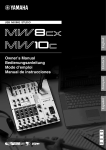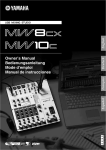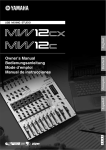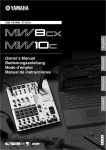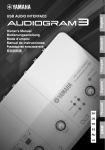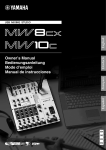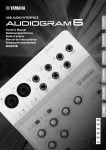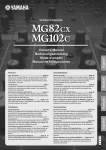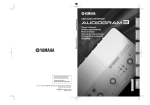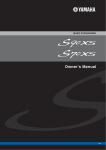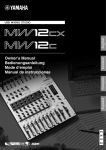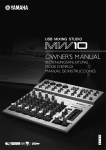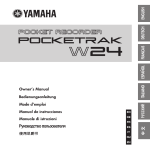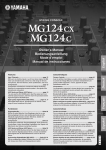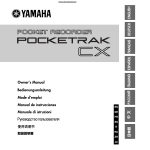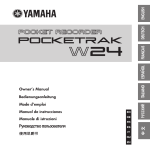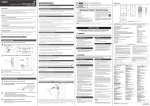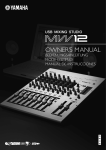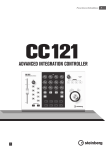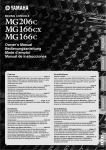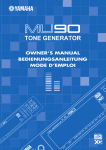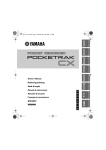Download MW8CX/MW10C Owner`s Manual
Transcript
English Deutsch Français Español Owner’s Manual Bedienungsanleitung Mode d’emploi Manual de instrucciones EN DE FR ES IMPORTANT NOTICE FOR THE UNITED KINGDOM Connecting the Plug and Cord IMPORTANT. The wires in this mains lead are coloured in accordance with the following code: BLUE : NEUTRAL BROWN : LIVE As the colours of the wires in the mains lead of this apparatus may not correspond with the coloured makings identifying the terminals in your plug proceed as follows: The wire which is coloured BLUE must be connected to the terminal which is marked with the letter N or coloured BLACK. The wire which is coloured BROWN must be connected to the terminal which is marked with the letter L or coloured RED. Making sure that neither core is connected to the earth terminal of the three pin plug. * This applies only to products distributed by Yamaha-Kemble Music (U.K.) Ltd. (2 wires) COMPLIANCE INFORMATION STATEMENT (DECLARATION OF CONFORMITY PROCEDURE) Responsible Party : Address : Telephone : Type of Equipment : Model Name : Yamaha Corporation of America 6600 Orangethorpe Ave., Buena Park, Calif. 90620 714-522-9011 USB Mixing Studio MW8CX/MW10C This device complies with Part 15 of the FCC Rules. Operation is subject to the following two conditions: 1) this device may not cause harmful interference, and 2) this device must accept any interference received including interference that may cause undesired operation. See user manual instructions if interference to radio reception is suspected. * This applies only to products distributed by YAMAHA CORPORATION OF AMERICA. (FCC DoC) FCC INFORMATION (U.S.A.) 1. IMPORTANT NOTICE: DO NOT MODIFY THIS UNIT! This product, when installed as indicated in the instructions contained in this manual, meets FCC requirements. Modifications not expressly approved by Yamaha may void your authority, granted by the FCC, to use the product. 2. IMPORTANT: When connecting this product to accessories and/or another product use only high quality shielded cables. Cable/s supplied with this product MUST be used. Follow all installation instructions. Failure to follow instructions could void your FCC authorization to use this product in the USA. 3. NOTE: This product has been tested and found to comply with the requirements listed in FCC Regulations, Part 15 for Class “B” digital devices. Compliance with these requirements provides a reasonable level of assurance that your use of this product in a residential environment will not result in harmful interference with other electronic devices. This equipment generates/uses radio frequencies and, if not installed and used according to the instructions found in the users manual, may cause interference harmful to the operation of other electronic devices. Compliance with FCC regula- * This applies only to products distributed by YAMAHA CORPORATION OF AMERICA. 2 MW8CX/MW10C Owner’s Manual tions does not guarantee that interference will not occur in all installations. If this product is found to be the source of interference, which can be determined by turning the unit “OFF” and “ON”, please try to eliminate the problem by using one of the following measures: Relocate either this product or the device that is being affected by the interference. Utilize power outlets that are on different branch (circuit breaker or fuse) circuits or install AC line filter/s. In the case of radio or TV interference, relocate/reorient the antenna. If the antenna lead-in is 300 ohm ribbon lead, change the lead-in to co-axial type cable. If these corrective measures do not produce satisfactory results, please contact the local retailer authorized to distribute this type of product. If you can not locate the appropriate retailer, please contact Yamaha Corporation of America, Electronic Service Division, 6600 Orangethorpe Ave, Buena Park, CA90620 The above statements apply ONLY to those products distributed by Yamaha Corporation of America or its subsidiaries. (class B) PRECAUTIONS PLEASE READ CAREFULLY BEFORE PROCEEDING * Please keep this manual in a safe place for future reference. WARNING Always follow the basic precautions listed below to avoid the possibility of serious injury or even death from electrical shock, short-circuiting, damages, fire or other hazards. These precautions include, but are not limited to, the following: Power supply/Power cord Water warning • Only use the voltage specified as correct for the device. The required voltage is printed on the name plate of the device. • Do not expose the device to rain, use it near water or in damp or wet conditions, or place containers on it containing liquids which might spill into any openings. • Use only the included AC power adaptor (PA-10 or an equivalent recommended by Yamaha). • Never insert or remove an electric plug with wet hands. • Do not place the power cord near heat sources such as heaters or radiators, and do not excessively bend or otherwise damage the cord, place heavy objects on it, or place it in a position where anyone could walk on, trip over, or roll anything over it. If you notice any abnormality • If the power cord or plug becomes frayed or damaged, or if there is a sudden loss of sound during use of the device, or if any unusual smells or smoke should appear to be caused by it, immediately turn off the power switch, disconnect the electric plug from the outlet, and have the device inspected by qualified Yamaha service personnel. Do not open • Do not open the device or attempt to disassemble the internal parts or modify them in any way. The device contains no user-serviceable parts. If it should appear to be malfunctioning, discontinue use immediately and have it inspected by qualified Yamaha service personnel. • If this device or the AC power adaptor should be dropped or damaged, immediately turn off the power switch, disconnect the electric plug from the outlet, and have the device inspected by qualified Yamaha service personnel. CAUTION Always follow the basic precautions listed below to avoid the possibility of physical injury to you or others, or damage to the device or other property. These precautions include, but are not limited to, the following: • Do not place the device in an unstable position where it might accidentally fall over. Power supply/Power cord • Remove the electric plug from the outlet when the device is not to be used for extended periods of time, or during electrical storms. • Do not use the device in the vicinity of a TV, radio, stereo equipment, mobile phone, or other electric devices. Doing so may result in noise, both in the device itself and in the TV or radio next to it. • When removing the electric plug from the device or an outlet, always hold the plug itself and not the cord. Pulling by the cord can damage it. • To avoid generating unwanted noise, make sure there is adequate distance (50 cm or more) between the AC power adaptor and the device. Connections • Before connecting the device to other devices, turn off the power for all devices. Before turning the power on or off for all devices, set all volume levels to minimum. • Do not cover or wrap the AC power adaptor with a cloth or blanket. Location Handling caution • Before moving the device, remove all connected cables. • When setting up the device, make sure that the AC outlet you are using is easily accessible. If some trouble or malfunction occurs, immediately turn off the power switch and disconnect the plug from the outlet. Even when the power switch is turned off, electricity is still flowing to the product all the minimum level. When you are not using the product for a long time, make sure to unplug the power cord from the wall AC outlet. • When turning on the AC power in your audio system, always turn on the power amplifier LAST, to avoid speaker damage. When turning the power off, the power amplifier should be turned off FIRST for the same reason. • Do not insert your fingers or hands in any gaps or openings on the device. • Avoid inserting or dropping foreign objects (paper, plastic, metal, etc.) into any gaps or openings on the device. If this happens, turn off the power immediately and unplug the power cord from the AC outlet. Then have the device inspected by qualified Yamaha service personnel. • Avoid setting all equalizer and controls to their maximum. Depending on the condition of the connected devices, doing so may cause feedback and may damage the speakers. • Do not use the device or headphones for a long period of time at a high or uncomfortable volume level, since this can cause permanent hearing loss. If you experience any hearing loss or ringing in the ears, consult a physician. • Do not expose the device to excessive dust or vibrations, or extreme cold or heat (such as in direct sunlight, near a heater, or in a car during the day) to prevent the possibility of panel disfiguration or damage to the internal components. • Do not rest your weight on the device or place heavy objects on it, and avoid use excessive force on the buttons, switches or connectors. (5)-4 MW8CX/MW10C Owner’s Manual 3 XLR-type connectors are wired as follows (IEC60268 standard): pin 1: ground, pin 2: hot (+), and pin 3: cold (-). Insert TRS phone jacks are wired as follows: sleeve: ground, tip: send, and ring: return. Yamaha cannot be held responsible for damage caused by improper use or modifications to the device, or data that is lost or destroyed. Always turn the power off when the device is not in use. Even when the power switch is in the “STANDBY” position, electricity is still flowing to the device at the minimum level. When you are not using the device for a long time, make sure you unplug the power cord from the wall AC outlet. The performance of components with moving contacts, such as switches, volume controls, and connectors, deteriorates over time. Consult qualifi ed Yamaha service personnel about replacing defective components. The MW mixer may heat up by as much as 15 to 20°C while the power is on. This is normal. Please note that the panel temperature may exceed 50°C in ambient temperatures higher than 30°C, and use caution to prevent burns. * This Owner’s Manual applies to both the MW8CX/MW10C. The main difference between the two models is that the MW8CX includes digital effects while the MW10C has no internal effects. * In this manual the term “MW mixsers” refers to both the MW8CX and MW10C. In cases where different features need to be described for each model, the MW8CX feature will be described first, followed by the MW10C feature in brackets: MW8CX (MW10C). SPECIAL NOTICES • The owner’s manual is the exclusive copyright of Yamaha Corporation. • The included software is the exclusive copyright of Steinberg Media Technologies GmbH. • Use of the software and this manual is governed by the license agreement which the purchaser fully agrees to upon breaking the seal of the software packaging. (Please read carefully the Software Licensing Agreement at the end of this manual before installing the application.) • Copying of the software or reproduction of this manual in whole or in part by any means is expressly forbidden without the written consent of the manufacturer. • Yamaha makes no representations or warranties with regard to the use of the software and documentation and cannot be held responsible for the results of the use of this manual and the software. • This disk is a DVD-ROM. Do not attempt to play the disk on a DVD player. Doing so may result in irreparable damage to your DVD player. • Visit the web address below for the latest information on supplied software and operating system requirements. <http://www.yamahasynth.com/> The illustrations and LCD screens as shown in this owner’s manual are for instructional purposes only, and may appear somewhat different from those on your instrument. This product incorporates and bundles computer programs and contents in which Yamaha owns copyrights or with respect to which it has license to use others’ copyrights. Such copyrighted materials include, without limitation, all computer software, style files, MIDI files, WAVE data, musical scores and sound recordings. Any unauthorized use of such programs and contents outside of personal use is not permitted under relevant laws. Any violation of copyright has legal consequences. DON’T MAKE, DISTRIBUTE OR USE ILLEGAL COPIES. Copying of the commercially available musical data including but not limited to MIDI data and/or audio data is strictly prohibited except for your personal use. • Windows is the registered trademarks of Microsoft® Corporation. • Apple and Macintosh are trademarks of Apple Computer, Inc., registered in the U.S. and other countries. • Steinberg and Cubase are the registered trademarks of Steinberg Media Technologies GmbH. • The company names and product names in this Owner’s Manual are the trademarks or registered trademarks of their respective companies. Specifications and descriptions in this owner’s manual are for information purposes only. Yamaha Corp. reserves the right to change or modify products or specifications at any time without prior notice. Since specifications, equipment or options may not be the same in every locale, please check with your Yamaha dealer. 4 MW8CX/MW10C Owner’s Manual Introduction Thank you for choosing a Yamaha MW8CX/MW10C USB Mixing Studio. The MW8CX/MW10C includes an audio mixer equipped with a USB interface for digital audio data transfer, and Cubase AI 4 DAW (Digital Audio Workstation) software for Windows® and Macintosh® computer operating systems. With the MW8CX/MW10C USB Mixing Studio and your personal computer you have the basic elements of a high-performance computer recording system that is easy to set up and operate. Please read through this manual carefully before beginning use, so that you will be able to take full advantage of your mixer’s superlative features and enjoy trouble-free operation for years to come. After reading the manual, please store it in a safe place. Features Connect To Your Computer via a Single USB Cable (page 7) The MW mixer connects to your computer via the supplied USB cable. Stereo audio data is transferred in both directions—from the mixer to the computer, and vice-versa—via the USB connection (44.1 kHz or 48 kHz sampling frequency). No Driver Installation Required (page 7) The MW system uses the standard drivers included in your computer’s operating system, so there’s no need to install any extra driver software. Cubase AI 4 DAW Software Supplied (page 7) Cubase AI 4 software, included in the MW package, offers versatile, high-performance hard-disk recording capability. Compression (page 9) Compression increase the overall level without introducing distortion by compressing excessive peaks in the signals from microphones and guitars. Mixer Functions (page 16) The MW mixer can handle up to 8 inputs (MW8CX) or 10 inputs (MW10C), mixing them to STEREO OUT or REC OUT. The MW mixer can simultaneously connect to a wide range of devices: microphones, line-level devices, stereo synthesizers, and more. 48V Phantom Power (page 18) A PHANTOM switch supplies +48V phantom power to the mixer’s microphone inputs, so you can use high-quality phantom-powered condenser microphones for superior recording quality. Accessories • • • • Cubase AI 4 DVD-ROM Power adaptor (PA-10)* USB cable Owner’s Manual (this book) * May not be included depending on your particular area. Please check with your Yamaha dealer. Contents Introduction...........................................5 Features...........................................................5 Contents...........................................................5 Before Turning on the Mixer ............................6 Turning the Power On/OFF..............................6 Computer System Requirements.....................6 Cubase AI 4 System Requirements.................6 ■ Mixer Basics................................ 7 Quick Guide ..........................................7 1. 2. 3. 4. 5. 6. Installing Cubase AI 4..................................7 Connecting to the MW mixer .......................7 Powering Up the System .............................8 Adjusting Level and Tone ............................9 Recording with Cubase AI 4 ......................10 Mixing with Cubase AI 4 ............................13 ■ Reference .................................. 15 Setup....................................................15 Front & Rear Panels ...........................16 Channel Control Section ................................16 Master Control Section ..................................18 Jack List .........................................................19 Digital Effect...................................................20 Rear Input/Output Section .............................20 Digital Effect Program List (Only MW8CX) ....21 Mounting to a Microphone Stand ...................21 Troubleshooting .................................22 Specifications .....................................90 Electrical Specifications .................................90 General Specifications ...................................90 Analog Input Specifications............................91 Analog Output Specifications.........................91 Digital Input/Output Specifications .................91 Dimensional Diagrams...................................92 Block Diagram and Level Diagram ................93 About the accessory disk ..................94 SOFTWARE LICENSE AGREEMENT ...94 MW8CX/MW10C Owner’s Manual 5 Introduction Before Turning on the Mixer 1 Be sure that the mixer’s power switch is in the STANDBY position. CAUTION 2 Use only the included power adaptor (PA-10) or an equivalent recommended by Yamaha. Use of a different adaptor may result in equipment damage, overheating, or fire. Connect the power adaptor to the AC ADAPTOR IN connector (q) on the rear of the mixer, and then turn the fastening ring clockwise (w) to secure the connection. w q Computer System Requirements Windows Vista Computer Windows-based computer with built-in USB interface OS Windows Vista CPU 1 GHz or higher Intel Core/Pentium/Celeron processor Memory 1 GB or more Windows XP Computer Windows-based computer with built-in USB interface OS Windows XP Professional/XP Home Edition CPU 750 MHz or higher Intel Core/Pentium/Celeron processor Memory 96 MB or more (128 MB or more recommended) Macintosh 3 Plug the power adaptor into a standard household power outlet. CAUTION Computer Macintosh computer with built-in USB interface OS MacOS X 10.3.3 or higher CPU Macintosh G3 300 MHz or higher/Intel processor Memory 128 MB or more • Be sure to unplug the adaptor from the outlet when not using the mixer, or when there are lightning storms in the area. • To avoid generating unwanted noise, make sure there is 50 cm or more between the power adaptor and the mixer. Cubase AI 4 System Requirements Windows Turning the Power On/OFF Press the mixer’s power switch to the ON position. When you are ready to turn the power off, press the power switch to the STANDBY position. CAUTION NOTE Note that trace current continues to flow while the switch is in the STANDBY position. If you do not plan to use the mixer again for a long while, please be sure to unplug the adaptor from the wall outlet. To prevent loud pops and noises, turn on the power to your sound gear starting with the sources (instruments, CD players, etc.) and ending with the power amplifier or powered speakers. Example : Instruments, microphones, and CD players first, then the mixer, and finally the power amplifier or powered speakers. When turning off the power to the system, reverse the order described above. 6 MW8CX/MW10C Owner’s Manual OS Windows XP Professional/XP Home Edition CPU 1.4 GHz or higher Intel Pentium processor Memory 512 MB or more Audio Interface Windows DirectX compatible Hard Disk 400 MB or more Macintosh OS MacOS X 10.4 or higher CPU Power Mac G4 1 GHz/Core Solo 1.5 GHz or higher Memory 512 MB or more Hard Disk 400 MB or more NOTE • A DVD driver is required for installation. • To activate your software license, install the application while the computer is connected to the internet. Mixer Basics Quick Guide Mixer Basics This quick setup and operation guide covers everything from installing the Cubase AI 4 software to using Cubase AI 4 for recording and mixdown. While going through this section you might find it useful to also refer to the “Front and Rear Panels” section on page 16, as well as the pdf manual supplied with the Cubase AI 4 software. Step 1 Installing Cubase AI 4 IMPORTANT ! 1 2 3 Since the End-User Software License Agreement (EUSLA) shown on your PC-display in your installing the “DAW” software is replaced by the agreement at the end of this manual, you should disregard the EUSLA. Read the Software License Agreement at the end of this manual carefully, and install the software if you agree to it. Start the computer and log on to the Administrator account. Insert the included DVD-ROM into the computer’s DVD-ROM drive. Open the “Cubase AI 4 for Windows” folder and double-click on the “CubaseAI4.msi”. Follow the on-screen instructions to install the Cubase AI 4 software. NOTE • When installing Cubase AI 4, you will need a working internet connection to register your Cubase AI 4. Make sure to fill in all required fields for user registration. If you do not register the product, you will be unable to use the application after a limited period of time expires. • For a Macintosh computer, double-click the “CubaseAI4.mkpg” icon for installation. Step 1 2 Connecting to the MW mixer Turn the power to the MW mixer and all gear that is to be connected to the MW mixer off/standby (except the computer), and set the LEVEL controls and STEREO Master control to their minimum settings. 2 Connect the MW mixer to your computer using the supplied USB cable. USB Connection Precautions Be sure to observe the following points when connecting to the computer’s USB interface. Failure to observe these rules can result in computer freezes/ hang-ups and possibly data loss or corruption. If the MW mixer or computer does hang up, turn the power to both devices off and then on again, and restart the computer. CAUTION • Be sure to wake the computer from sleep/suspended/standby mode before making a connection to the computer’s USB connector. • Connect the MW mixer to the computer before turning the MW mixer power on. • Always quit all applications running on the computer before turning the MW mixer’s power on or off, or connecting or disconnecting the USB cable. • Wait at least 6 seconds between turning the MW mixer on or off, and between connecting or disconnecting the USB cable. LEVEL controls STEREO Master control CAUTION NOTE When connecting or disconnecting the USB cable be sure to turn the 2TR IN/USB control all the way down. Disconnect the USB cable when using the MW mixer without the computer. MW8CX/MW10C Owner’s Manual 7 Mixer Basics Quick Guide 3 Connecting Microphones and/or Instruments. For details on making connections refer to the “Setup” section on page 15 and the “Front & Rear Panels” section on page 16. Step 3 Powering Up the System To prevent loud pops and noises, turn on the power to your sound gear starting with the sources (instruments, CD players, etc.) and ending with the power amplifier or powered speakers. Example : Instruments, microphones, and CD players first, then the mixer, and finally the power amplifier or powered speakers. Be sure to turn the MW mixer PHANTOM switch on when using phantom-powered condenser microphones. Observe the following precautions when turning on phantom power. CAUTION • Make sure that the PHANTOM switch is off when phantom power is not needed. • When turning the switch on, be sure that only condenser microphones are connected to the XLR input jacks. Other devices may be damaged if connected to phantom power. This precaution does not apply to balanced dynamic microphones, however, as these will not be affected by phantom power. DI • To minimize the possibility of speaker damage, turn phantom power on ONLY while your power amplifier or powered speakers are switched off. It’s also a good idea to turn the mixer’s output controls—STEREO Master control—all the way down. USB cable Although electric guitars and basses can be connected directly to the mixer’s inputs, the sound is likely to be thin and possibly noisy. For best results with these types of instruments use a DI box (direct box) or amp simulator between the instrument and the mixer. NOTE • We recommend that you set the computer output to the maximum level and mute the computer’s internal speaker. For details on how to make the setting refer to the “The recorded sound is too low in level.” in the “Troubleshooting” on page 22. • The first time you connect to the computer’s USB connector, or change the connection to a different USB port, a driver installation display may appear after turning the power to the MW mixer on. If this occurs, wait until the installation is complete before proceeding. Balanced Cables and Unbalanced Cables Two types of cables can be used to connect microphones, electronic instruments, and other audio sources to the mixer’s inputs, as well as to connect the mixer’s outputs to a power amplifier or related gear: balanced or unbalanced. Balanced cables are highly resistant to noise, and are the best choice for low-level signals such as the output from microphones, as well as for long cable runs. Unbalanced cables are generally used for short runs from line-level sources such as synthesizers. Cable Guidelines Microphone cable Short line-level cables Long line-level cables Balanced is best. Unbalanced cable is fine in a relatively noise-free environment. Balanced is best. Connector Types XLR Connectors This 3-pin connector is resistant to externally induced noise, and is used primarily for balanced connections. With properly designed receiving circuitry cables with this type of connector can also be used for unbalanced signals. XLR type connectors are the standard for microphone connections as well as most professional audio gear. 8 MW8CX/MW10C Owner’s Manual Phone Connectors Phone connectors are available in mono and stereo versions. Stereo types are also known as “TRS” connectors (Tip-Ring-Sleeve), and are used for stereo headphone jacks, insert jacks, and also to carry balanced signals in many cases. Unbalanced types are used for mono signals -guitar cables are a common example. RCA Pin Connectors This type of unbalanced connector is most commonly found on home audio and video equipment. RCA type pin jacks are often color coded: white for left audio channel and red for right audio channel, for example. Mixer Basics Quick Guide Step 4 Adjusting Level and Tone Level Adjustment Tone Adjustment 1 The first step is to set the level controls on all instruments and other sources appropriately. 2 Adjust the channel GAIN controls so that the corresponding PEAK indicators flash briefly on the highest peak levels. (GAIN controls are not provided on the stereo channels—7/8 (MW8CX), or 7/8 and 9/10 (MW10C)). 3 Raise the STEREO Master control to the “▼” position. 4 Adjust the LEVEL control to create the desired initial balance while monitoring via headphones or monitor speakers. The overall headphone level is adjusted by the MONITOR/PHONES control. The MW mixer’s compressors and 3-band equalizers make it easy to shape the tone of independent channels to achieve the best possible mix. Use the High-pass Filter for Microphone Input As the name implies, a “high-pass filter” allows only signals above a certain frequency to pass. Conversely, signals below that “cutoff frequency” are attenuated. When an MW highpass filter is turned on, signals below 80 Hz are attenuated. This can be useful for minimizing low-frequency breath noise from a vocalist, as well as handling noise, or rumble transmitted via the microphone stand. It is generally a good idea to turn the high-pass filter on for microphone channels. Compression One form of compression known as “limiting” can, when properly used, produce a smooth, unified sound with no excessive peaks or distortion. A common example of the use of compression is to “tame” a vocal that has a wide dynamic range in order to tighten up the mix. Compression can also be applied to guitar tracks to add extra sustain. Too much compression can be a cause of feedback, however, so use it sparingly. OUTPUT (Min) GAIN control (Max) PEAK indicator INPUT Equalizer Tips LEVEL controls MONITOR/PHONES control STEREO Master control The best advice that can be given regarding equalization while recording is simply to use as little equalization as possible. If you want a little more presence you can turn the HIGH end up a bit. Or you can boost the bass a little if you feel the low end is lacking. During recording it’s better to use EQ sparingly for compensation only. MW8CX/MW10C Owner’s Manual 9 Mixer Basics Quick Guide Step 5 Recording with Cubase AI 4 This section describes the procedure for recording to the Cubase AI 4 software we installed earlier via the MW mixer. NOTE For details on operation of the Cubase AI 4 software refer to the pdf-format manual provided with the software. Cubase AI 4 Setup 1 2 To prevent the playback sound from Cubase AI 4 from being directly rerecorded, set the MW mixer’s 2TR IN/USB switch to TO MONITOR ( ). 3 Select [Device Setup] from the [Device] menu to open the Device Setup window. Windows: Select [VST Audio System] in the [Device] field on the left side of the window. Select [ASIO DirectX Full Duplex Driver] in the [ASIO Driver] field on the right side of the window. A dialog window will appear asking “Do you want to switch the ASIO driver?”. Click [Switch]. Launch Cubase AI 4. Windows: Click [Start] → [All Program] → [Steinberg Cubase AI 4] → [Cubase AI 4] to launch the program. If the ASIO Multimedia dialog window appears, click [Yes]. Macintosh: Macintosh: Double-click the [Application] → [Cubase AI 4]. NOTE • If you specified a file destination when installing the Cubase AI 4 software, launch the application from that location. • Create a Cubase AI 4 shortcut or alias on your desktop so you can easily launch the program when required. 10 MW8CX/MW10C Owner’s Manual Select [VST Audio System] in the [Device] field on the left side of the window. Select [USB Audio CODEC (2)] in the [ASIO Driver] field on the right side of the window, and click [OK]. Skip ahead to step 6, below. NOTE Under Mac OS X you can select either [USB Audio CODEC (1)] or [USB Audio CODEC (2)] in the [ASIO Driver] field. Normally you should select [USB Audio CODEC (2)], but if you will only be playing back and mixing previously recorded data you can select [USB Audio CODEC (1)] to lighten the load on the computer’s CPU. Mixer Basics Quick Guide 4 On a Windows computer select [ASIO DirectX Full Duplex Driver] in the [Devices] field on the left side of the Device Setup window, and click [Control Panel] on the right side of the window. 7 Select [New Project] from the [File] menu to create a new project file. The new project dialog window will open. For this example select [CAI4 - 4 Stereo 8 Mono Audio Track Recorder] and click [OK]. NOTE 5 Recorded Cubase AI 4 data is stored as a “project file”. The ASIO Direct Sound Full Duplex Setup dialog window will be displayed. Check only the input port and output port [USB Audio CODEC] checkbox. 8 When the directory selection dialog window appears, select the folder to which the project and audio files for the project are to be stored, and click [OK]. An empty project window with 4 stereo and 8 monaural tracks will appear. Project window 6 Mixer window Make sure that “USB Audio CODEC 1/2” are shown in the [Port System Name] field, and check the [Visible] column in the Device Setup window. Click [OK] to close the window. NOTE If the [Port System Name] field does not change, close and restart the Cubase AI 4, then open the Device Setup window. Transport panel MW8CX/MW10C Owner’s Manual 11 Mixer Basics Quick Guide 4 Preparing to Record 1 Click in the track list (the area in which the track names are displayed) to select a track to record on. Play the instrument to be recorded, and adjust the MW mixer’s GAIN control, LEVEL controls and STEREO master control so that the Clipping indicator never light. The various settings for the selected track are available in the Inspector on the left side of the display. <Transport panel> [Record Enable] button Clipping indicator Track list 5 Specify the point at which you want to start recording via the ruler at the top of the project window. Click the black area of the ruler to move the project cursor (the vertical black line) to that position. Ruler Inspector Input routing NOTE Recording and Playback 1 When recording is started the project cursor will begin moving to the right and a box that displays the recording results will be created. You will normally use a stereo track when recording synthesizers, and a monaural track when recording vocals or guitar. 2 Click the Input Routing field in the Inspector to select the audio input source. Select “Stereo In 1” for a stereo track and “Left (Right)-Stereo In 1” for a monaural track. 3 Make sure the [Record Enable] button for the track to be recorded is turned on. Click the Transport panel [Record] button to begin recording. <Transport panel> Rewind Record Start Forward If the [Record Enable] button is off, click it to turn it on. Stop Recording results 2 3 12 MW8CX/MW10C Owner’s Manual Play the part. When you finish recording the track, click the Transport panel [Stop] button. Mixer Basics Quick Guide 4 To hear playback of the track you have just recorded, use either the Transport panel [Rewind] button or the ruler to rewind to the beginning of the recorded section, then click the Transport panel [Start] button. The overall playback level will be displayed via the master section bus level meter on the right side of the mixer window, and the channel level will be displayed via the channel strip level meter. NOTE • Click the [Narrow/Wide] button in the upper left corner of the mixer window to increase the width of the mixer’s channel strips. • The output signal from Cubase AI 4 is routed to the MW mixer’s 2TR IN inputs. To hear the playback sound via a pair of headphones plugged into the MW mixer, set the bus select switch to TO MONITOR ( ) and adjust the volume with the 2TR IN/USB control and the MONITOR/ PHONES control. [Narrow/Wide] button Level meter Step 5 To save the project file select [Save] from the [File] menu and enter a file name before actually saving the file. Save your project file frequently to insure against losing large amounts of data if a problem occurs. 6 Repeat steps 1 through 5 to record further material on the same track. 7 To record additional material on a different track, select a new track and repeat the record procedure. NOTE You can monitor the sound being recorded and a previously recorded sound simultaneously while recording (MONITOR MIX). Refer to “ B 2TR IN/USB” on page 19 for details. [Narrow/Wide] button Bus level meter 6 Mixing with Cubase AI 4 In this section we’ll try mixing down multiple recorded audio tracks to stereo, and creating a wav file. Mixes can be stored as WAV or AIFF files, which can then be recorded to audio CDs. 1 Launch Cubase AI 4 and open a project file. 2 Click the [Start] button on the Transport Panel. 3 While listening to playback, drag the channel strip level faders up and down to create the desired initial balance, then adjust the overall volume using the bus volume fader. Start with the Featured Part You can start working on a mix from almost any part, but it makes the most sense to start with the main instrument or vocal. Set up an initial level for the main part, and then build the rest of the mix around it. For example, if you’re mixing a piano trio with a vocalist, begin by setting the level of the vocal track at around the nominal level, and then gradually add the other instruments. Your choices will also be influenced by the type of music you are working on. If the song is a ballad you might want to add the piano to the mix after the vocal, and then add the bass and drums. If it’s a more rhythmically oriented piece you could add the bass and drums first, and then the piano. Whatever best serves the music is right. MW8CX/MW10C Owner’s Manual 13 Mixer Basics Quick Guide 4 Drag the pan controls on the top of the channel strips left and right to set the stereo position of each track. 6 When the final mix adjustments have been made, go to the [File] menu and select [Export] → [Audio Mixdown]. 7 Enter a file name and select a destination for the file as well as a file type. If you intend to use the file to create an audio CD, select the WAV file type (AIFF on Macintosh OS X), Stereo Out (stereo), 16 bit, and 44.1 kHz. Pan Effectively “Panning” creates the illusion of stereo space by changing the relative levels of each track’s signal sent to the left and right speakers. If a signal is sent only to the left speaker, the sound will appear to come from the far left side of the stereo sound field. If it sent with equal level to both left and right speakers our ears tell us the sound is located in the center of the stage. Judicious panning can also help to create cleanersounding mixes by spreading the instruments out across the sound stage so that they don’t “get in each other’s way.” There are no hard and fast rules, but the bass and kick drum are usually placed in the center of the mix, as is the lead instrument or vocal. Other instruments should be evenly balanced throughout the sound stage in a well-balanced manner. 5 At this point you can begin to use EQ to refine your mix, and add effects. As an example let’s try adding reverb. Click the [Edit] button ( ) on the left side of the channel strip to open the VST audio channel settings window. Click Insert 1 and select Earlier VST Plug-ins → Reverb → RoomWorks SE. NOTE CAUTION 14 For further details refer to the pdf manual provided with the Cubase AI 4 software. It’s a good idea to lower the channel fader a bit before adding an effect, since the effect can cause an increase in the overall channel level. MW8CX/MW10C Owner’s Manual 8 Click [Export]. Progress of the mixdown operation will be shown in a progress window. When the progress window closes the mixdown is complete. NOTE Wave files created by mixdown can be directly played back using the Windows Media Player, or iTunes on a Macintosh computer. Reference Setup Reference Synthesizer Powered Speakers Guitar CD Player Bass Recorder DI Microphone Effect Processor (exciter) Foot Switch (YAMAHA FC5) Headphones Powered Monitor Speakers Effect Processor Personal Computer MW8CX MW8CX/MW10C Owner’s Manual 15 Reference Front & Rear Panels The following applies to both the MW8CX and MW10C. In cases where different features need to be described for each model, the MW8CX feature will be described first, followed by the MW10C feature in brackets: MW8CX (MW10C). Channel Control Section 1 MIC Input Jacks (CHs 1 to 5/6) Channels 1 and 2 (Monaural) 1 Channels 3/4 and 5/6 (Stereo) 1 Channels 7/8 (7/8 and 9/10) (Stereo) These are balanced XLR-type microphone input jacks (1:Ground; 2:Hot; 3:Cold). 2 LINE Input Jacks (CHs 1, 2) These are balanced TRS phone-jack line inputs (T:Hot; R:Cold; S:Ground). You can connect either balanced or unbalanced phone plugs to these jacks. 4 3 LINE Input Jacks (CHs 3/4 to 7/8 (CHs 3/4 to 2 3 9/10)) 3 These are unbalanced phone-jack stereo line inputs. 5 4 LINE Input Jacks (CH 7/8, (CHs 7/8, 9/10)) These are unbalanced stereo RCA pin jacks. Where an input channel provides both a MIC input jack and a LINE input jack, or a LINE input jack and an RCA pin jack, you can use either jack but not both at the same time. Please connect to only one jack on each channel. NOTE 6 6 7 7 8 5 INSERT Jacks (CHs 1, 2) 9 9 0 0 Each of these jacks provides an insert point between the equalizer and LEVEL control of the corresponding input channel (CHs 1, 2). The INSERT jacks are ideal for connecting devices such as graphic equalizers, compressors, or noise filters into the corresponding channels. These are TRS (tip, ring, sleeve) phone jacks that carry both the send and return signal (tip = send/out; ring = return/in; sleeve = ground). 0 Patching external devices via an INSERT jack requires a special insert cable such as illustrated below (insert cable sold separately). NOTE A A A B B B C C C To the input jack of the external processor To the INSERT I/O jack MW8CX Sleeve (Ground) Ring: IN Tip: OUT Tip: OUT Tip: IN To the output jack of the external processor CAUTION 16 MW8CX/MW10C Owner’s Manual The signal output from the INSERT jacks is reverse-phased. This should not be a problem when connecting to an effect unit, but please be aware of the possiblility of phase conflict when connecting to other types of device. A reversedphased signal may result in degraded sound quality or even complete sound cancellation. Reference Front & Rear Panels 6 GAIN Control B PAN Control (CHs 1, 2) Adjusts the input signal level. To achieve the best balance between S/N ratio and dynamic range, adjust the level so that the PEAK indicator 9 lights only occasionally and briefly on the highest input transients. The -60 to -16 scale is the MIC input adjustment range. The -34 to +10 scale is the LINE input adjustment range. 7 Switch (High Pass Filter) This switch toggles the HPF on or off. To turn the HPF on, press the switch in ( ). The HPF cuts frequencies below 80 Hz (the HPF does not apply to the line inputs of stereo input channels 34). PAN/BAL Control (CHs 3/4, 5/6) BAL Control (CH 7/8 (CHs 7/8, 9/10) The PAN control determines the stereo positioning of the channel signal on the Stereo L and R buses. The BAL control knob sets the balance between left and right channels. Signals input to the L input (odd channel) go to the Stereo L bus; signals input to the R input (even channel) go to the Stereo R bus. NOTE 8 COMP Control Adjusts the amount of compression applied to the channel. As the knob is turned to the right the compression ratio increases while the output gain is automatically adjusted accordingly. The result is smoother, more even dynamics because louder signals are attenuated while the overall level is boosted. NOTE On channels where this knob provides both PAN and BAL control (channels 3/4 and 5/6), the knob operates as a PAN control when input is received via the MIC jack or L (MONO) input only, and as a BAL control when input is received via both L and R inputs. C LEVEL Control Adjusts the level of the channel signal. Use these knobs to adjust the balance between the various channels. NOTE Set the controls for unused channels all the way down to minimize noise. Avoid setting the compression too high, as the the higher average output level that results may lead to feedback. 9 PEAK Indicator The peak level of the post-EQ signal is detected, and the PEAK indicator lights red when the level reaches 3 dB below clipping. For XLR-equipped stereo input channels (3/ 4 and 5/6), both the post-EQ and post-mic-amp peak levels are detected, and the indicator lights red if either of these levels reaches 3 dB below clipping. 0 Equalizer (HIGH, MID, and LOW) This three-band equalizer adjusts the channel’s high, mid, and low frequency bands. CH 7/8 (CHs 7/8, 9/10) have two bands: high and low. Setting the knob to the ▼ position produces a flat response in the corresponding band. Turning the knob to the right boosts the corresponding frequency band, while turning to the left attenuates the band. The following table shows the EQ type, frequency, and maximum cut/boost for each of the three bands. Band Type Frequency HIGH Shelving 10 kHz MID Peaking 2.5 kHz LOW Shelving 100 Hz Maximum Cut/Boost ±15 dB A EFFECT (AUX) Control Adjusts the level of the signal sent from the channel to the EFFECT (AUX) bus. Note that the signal level sent to the bus is also affected by the LEVEL control C. On stereo channels (CHs 3/4 to 7/8 (CHs 3/4 to 9/10)) the signals from the L (odd) and R (even) channels are mixed and then sent to the EFFECT (AUX) bus. MW8CX/MW10C Owner’s Manual 17 Reference Front & Rear Panels Master Control Section 3 RETURN L (MONO), R Jacks 1 These are unbalanced phone-jack type line inputs. The signal received by these jacks is sent to the STEREO L/R bus. These jacks are typically used to receive the signal returned from an external effect device (reverb, delay, etc.). 2 NOTE 5 3 6 4 These jacks can also be used as an auxiliary stereo input. If you connect to the L (MONO) jack only, the mixer will recognize the signal as monaural and will send the identical signal to both the L and R jacks. 4 SEND EFFECT (AUX) Jack This is an impedance balanced* TRS phone jack that outputs the signal from the EFFECT (AUX) bus. You can use this jack, for example, to connect to an external effect unit. 7 5 STEREO OUT (L, R) Jacks These are impedance balanced* TRS phone jacks that output the signals adjusted by the STEREO Master control E. You can use these jacks, for example, to connect to the power amplifier driving your main speakers. 6 MONITOR (L, R) Jacks 0 8 A These are impedance balanced* TRS phone jacks that output the signals adjusted by the MONITOR/PHONES control C. Connect these jacks to your monitor system. 7 PHONES Jack Connect a pair of headphones to this TRS phone jack. The PHONES jack outputs the same signal as the MONITOR OUT jacks. 9 8 PHANTOM +48 V Switch B D C This switch toggles phantom power on and off. When the switch is on the mixer supplies +48V phantom power to all channels that have XLR mic input jacks (CHs 1–5/6). Turn this switch on when using one or more phantom-powered condenser microphones. NOTE MW8CX When this switch is on the mixer supplies DC +48 V power to pins 2 and 3 of all XLR-type MIC INPUT jacks. • Be sure to leave this switch off ( not need phantom power. 1 2TR IN Jacks These RCA pin jacks can be used to input a stereo sound source. Use these jacks when you want to connect a CD player directly to the mixer. NOTE Select where you want to send the signal using the 2TR IN/USB switch B, and adjust the signal level using the 2TR IN/USB control in the Master Control section. 2 REC OUT (L, R) Jacks These RCA pin jacks can be connected to an external recorder such as an MD recorder in order to record the same signal that is being output via the STEREO OUT jacks. NOTE 18 The mixer’s STEREO Master control has no affect on the signal output via these jacks. Be sure to make appropriate level adjustments at the recording device. MW8CX/MW10C Owner’s Manual CAUTION ) if you do • When tuning the switch on ( ), be sure that only condenser mics are connected to the XLR input jacks (CHs: 1 to 5/6). Devices other than condenser mics may be damaged if connected to the phantom power supply. Note, however, that the switch may be left on when connecting to balanced dynamic microphones. • To avoid damage to speakers, be sure to turn off amplifiers (or powered speakers) before turning this switch on or off. We also recommend that you turn all output controls (STEREO Master control, etc.) to their minimum settings before operating the switch to avoid the risk of loud noises that could cause hearing loss or device damage. Reference Front & Rear Panels 9 RETURN Control MONITOR MIX Signal Flow Adjusts the level at which the signal received at the RETURN jacks (L (MONO) and R) is sent to the STEREO L/R bus. If you supply a signal to the RETURN L (MONO) jack only, the mixer sends the same signal to both the L and R Stereo buses. NOTE 2TR IN/ USB 2TR IN/USB control Playback signal Recording signal MONITOR/PHONES controls MONITOR/ PHONES jacks STEREO bus STEREO Master control 0 POWER Indicator REC OUT/USB This indicator lights when the mixer’s power is ON. A Level Meter • 2TR IN/USB control This LED meter displays the level of the signal sent to the STEREO OUT jacks, MONITOR jacks and the PHONES jack. The “0” segment corresponds to the nominal output level. The PEAK segment lights red when the output reaches the clipping level. B 2TR IN/USB C MONITOR/PHONES Control Controls the level of the signal output to the PHONES jack and the MONITOR jacks. D STEREO Master Control • 2TR IN/USB Switch If it is set to TO STEREO ( ), the signals input via the 2TR IN jacks and the USB connector are sent to the STEREO L/R bus. If this switch is set to TO MONITOR ( ), the signals are sent to the MONITOR OUT jacks, the PHONES jack, and the level meter. The MONITOR MIX feature becomes available when it is set to TO MONITOR ( ). * Adjusts the level of the signal sent from the 2TR IN jacks and USB connector to the STEREO L/R bus. : When overdubbing, you can adjust the levels of the monitor playback signal and the signal being recorded separately. Adjusts the signal level sent to the STEREO OUT jacks. * Impedance Balanced Since the hot and cold terminals of impedance balanced output jacks have the same impedance, these outputs are less affected by induced noise. Jack List Input and Output Jacks Polarities Configurations INPUT MIC INPUT OUTPUT Pin 1: Ground Pin 2: Hot (+) Pin 3: Cold (-) XLR Connector LINE INPUT (stereo channels) STEREO OUT, MONITOR, EFFECT (AUX)* Tip: Hot (+) Ring: Cold (-) Sleeve: Ground INSERT Tip: Output Ring: Input Sleeve: Ground PHONES Tip: L Ring: R Sleeve: Ground RETURN LINE INPUT (monaural channels) Ring Sleeve Tip TRS Phone Connector Tip: Hot Sleeve: Ground Sleeve Tip Phone Connector * These jacks will also accept connection to monaural phone connectors. If you use monaural plugs, the connection will be unbalanced. MW8CX/MW10C Owner’s Manual 19 Reference Front & Rear Panels Digital Effect * Only the MW8CX has digital effects. 1 FOOT SWITCH Jack A YAMAHA FC5 foot switch (sold separately) can be connected to this jack and used to toggle the digital effects ON and OFF. 2 PROGRAM Dial Selects one of the 16 internal effects. See page 21 for details about the internal effects. 1 3 PARAMETER Control Adjusts the parameter (depth, speed, etc.) for the selected effect. The last value used with each effect type is saved. NOTE When you change to a different effect type, the mixer automatically restores the value that was previously used with the newly selected effect (regardless of the current position of the PARAMETER Control knob). These parameter values are reset when the power is turned off. 4 ON Switch Switches the internal effect on or off. The internal effect is applied only if this switch is turned on. The switch lights orange when on. An optional YAMAHA FC5 foot switch (sold separately) can be used to toggle the digital effects ON and OFF. 2 NOTE The ON switch lights and the internal effect unit is active by default when the power is initially turned on. 5 EFFECT RTN Control 3 Adjusts the signal level sent from the internal digital effect unit to the STEREO bus. The EFFECT RTN control does not affect the level of the signal sent to the SEND EFFECT jack. 4 5 MW8CX Rear Input/Output Section 1 POWER Switch Use this switch to turn the mixer’s power ON or to STANDBY mode. CAUTION Note that a small current continues to flow while the switch is in the STANDBY position. If you do not plan to use the mixer for a while, be sure to unplug the AC adaptor from the wall outlet. 2 AC ADAPTOR IN Connector 1 2 3 Connect the supplied power adaptor to this connector (see page 6). 3 USB Connector Connects to the computer via the included cable. The USB connector outputs the same signal as the REC OUT jacks. CAUTION 20 MW8CX/MW10C Owner’s Manual When connecting or disconnecting the USB cable be sure to turn the 2TR IN/USB control all the way down. Reference Front & Rear Panels Digital Effect Program List (Only MW8CX) No Program Parameter Description 1 REVERB HALL 1 REVERB TIME 2 REVERB HALL 2 REVERB TIME 3 REVERB ROOM 1 REVERB TIME 4 REVERB ROOM 2 REVERB TIME 5 REVERB STAGE 1 REVERB TIME 6 REVERB STAGE 2 REVERB TIME 7 REVERB PLATE REVERB TIME Simulation of a metal-plate reverb unit, producing a more hard-edged sound. 8 DRUM AMBIENCE REVERB TIME A short reverb that is ideal for use with kick drum. 9 KARAOKE ECHO DELAY TIME Echo designed for karaoke (sing-along) applications. 10 VOCAL ECHO DELAY TIME Echo suitable for vocals. 11 CHORUS 1 LFO Frequency 12 CHORUS 2 LFO Frequency Creates a thick sound by modulating the delay time. The PARAMETER control adjusts the frequency of the LFO* that modulates the delay time. 13 FLANGER LFO Frequency A sweeping pitched effect. The PARAMETER control adjusts the frequency of the LFO* that modulates the delay time. 14 PHASER LFO Frequency Phase modulation produces a cyclical phasing effect. The PARAMETER control adjusts the frequency of the LFO* that modulates the delay time. 15 AUTO WAH LFO Frequency A wah-wah effect with cyclical filter modulation. The PARAMETER control adjusts the frequency of the LFO* that modulates the delay time. 16 DISTORTION DRIVE Adds a sharp-edged distortion to the sound. Reverb simulating a large space such as a concert hall. Reverb simulating the acoustics of a small space (room). Reverb simulating a large stage. * “LFO” stands for Low Frequency Oscillator. An LFO is normally used to modulate another signal, determining the modulation speed and waveform shape. Mounting to a Microphone Stand CAUTION • When using the mixer on a microphone stand, be sure to set the stand on a level and stable surface. Do not set up the stand in locations subject to vibrations or wind. • Note that mixer may be damaged if the stand should fall over. Attach the connection cables carefully so that the cables will not catch on the equipment and cause it to fall. For example: arrange the cables so that they run parallel with the microphone pole down to the base of the stand. 2 Turn the mixer right-side up, and mount it onto your microphone stand. 3 Loosen the angle adjustment wingnut (q), adjust the mixer’s angle as desired (w), and then tighten the wingnut securely (e). • Leave ample free space around the stand. 1 Turn the mixer upside-down, and hold the microphone-stand adaptor (BMS-10A; sold separately) against the bottom of the mixer so that the screw holes are aligned (q). Screw the adaptor firmly into place with the two screws (w). For more information, refer to the BMS-10A Owner’s Manual. MW8CX/MW10C Owner’s Manual 21 Reference Troubleshooting The MW mixer won’t turn on. ❑ Is the included adaptor properly plugged into both the mixer and an appropriate AC wall The system doesn’t work properly. ❑ Are the USB cable and all necessary audio cables properly connected? ❑ Are you using a USB hub? outlet? USB hubs can interfere with proper operation, so try connecting the MW mixer directly to a USB port on the computer. If the computer has multiple USB ports, try a different USB port. ❑ Are you using other USB devices at the same time? If so, try removing the other device(s) and connecting only the Yamaha USB device. No sound. ❑ Are your speaker cables connected properly, or are they shorted? ❑ Are the volume controls of your sources, audio devices, applications software, computer operating system, etc., set at appropriate levels? ❑ Is the output of your computer operating system muted? ❑ Do you have several applications running at the same time? Be sure to quit all applications you are not using. ❑ Is the sound output of your computer operating system assigned properly? Windows: 1. From the [START] menu click [Control Panel], then double-click the “Sounds and Audio Devices” icon to open the “Sounds and Audio Devices Properties” dialog window. 2. Click the “Audio” tab. 3. Set “Sound playback: Default device” and “Sound recording: Default device” to “USB Audio CODEC.” 4. Click [OK]. Macintosh: 1. Select “System Preferences ...” from the Apple menu and then select “Sound” to open the “Sound” dialog window. 2. Click the “Input” tab and under “Choose a device for sound input” select “USB Audio CODEC”. 3. Click the “Output” tab and under “Choose a device for sound output” select “USB Audio CODEC”. ❑ Is the sound output of the Cubase AI 4 application assigned properly? For setup details refer to page 7 of the Quick Guide. The recorded sound is too low in level. ❑ Is the computer’s output level setting too low? We recommend that you set the computer output to the maximum level and mute the computer’s internal speaker. Windows: 1. From the [START] menu click [Control Panel], then double-click the “Sounds and Audio Devices” icon to open the “Sounds and Audio Devices Properties” dialog window. 2. Click the “Volume” tab. 3. Set “Device volume” to “High.” 4. Click the “Sound” tab. 5. Select “No sound” in the “Sound scheme.” Macintosh: 1. Select [System Preferences ...] from the Apple menu and then select “Sound” to open the “Sound” dialog window. 2. Click the “Output” tab and set the volume slider at the bottom of the window to its maximum level. 3. Click the “Sound Effect” tab and set the volume slider of the “Alert volume” slider to its minimum level. ❑ Have you connected or disconnected the USB cable while Cubase AI 4 is running? Doing so can sometimes cause the Windows output level to be reset to its default level. Check and raise the output level if necessary. 22 MW8CX/MW10C Owner’s Manual Reference Troubleshooting The sound is intermittent or distorted. ❑ Is the PEAK indicator flashing read? You might have to lower GAIN control or LEVEL control levels to avoid distortion. ❑ Are you applying the effects and compressor at an appropriate level? You might have to lower EFFECT RTN control and COMP control levels. ❑ Does the computer you are using meet the listed system requirements? Refer to “Computer System Requirements” on page 6 for details. ❑ Are any other applications, device drivers, or USB devices (scanners, printers, etc.) running at the same time? Be sure to quit all applications you are not using. ❑ Are you playing back a large number of audio tracks? The number of tracks you can play at the same time will depend on the performance of the computer you are using. You may experience intermittent playback if you exceed your computer’s capabilities. ❑ Are you recording or playing long continuous sections of audio? The audio data processing capabilities of your computer will depend on a number of factors including CPU speed and access to external devices. On Windows computers, changing some settings as outlined below can improve performance. 1. Click [Control Panel] from the [START] menu, and double-click the “Sounds and Audio Devices” icon to open the “Sounds and Audio Devices Properties” dialog window. 2. Click the “Volume” tab and click “Advanced” in “Speaker settings.” The “Advanced Audio Properties” dialog window will open. 3. Click the “Performance” tab. Set “Hardware acceleration” to “Full”, and “Sample rate conversion quality” to “Good.” Don’t change these settings if you are not familiar with your computer’s operating system. Check that the file system is set properly, and make sure that you have a plenty of free memory (more than 128 megabytes). If the wave files you are recording or playing are not too large, changing the virtual memory settings can sometimes improve audio performance. In some cases it might be necessary to update your hard disk controller, device drivers, or BIOS. Refer to your computer’s support center or support page on the web for more information. ❑ Try adding memory. Adding more RAM memory can significantly increase your computer’s audio performance. Refer to your computer’s owner’s manual for information on installing and setting up extra memory. There is a delay when playing a software synthesizer via a MIDI keyboard (latency). ❑ Check the URL listed below for the latest information. <http://www.yamahasynth.com/> MW8CX/MW10C Owner’s Manual 23 Reference Specifications ■ Electrical Specifications Frequency Response Total Harmonic Distortion (THD + N) Hum & Noise Hum & Noise are measured with a 6 dB/ octave filter @12.7 kHz; equivalent to a 20 kHz filter with infinite dB/octave attenuation. Crosstalk (1 kHz) Maximum Voltage Gain (1 kHz) All level controls are maximum when measured PAN/BAL: panned hard left or hard right. Phantom Voltage STEREO OUT EFFECT SEND (AUX SEND*) MONITOR OUT, REC OUT STEREO OUT GAIN: min (CHs 1–5/6) 20 Hz–20 kHz Nominal output level @1 kHz MIN -3.0 TYP -3.0 1.0 -3.0 dB 1.0 +14 dBu, 20 Hz–20 kHz, Input Gain Control at minimum Input: CH INPUT 1, 2 MIC EIN (Equivalent Input Noise): Rs = 150 Ω, GAIN: maximum (CH1, 2) STEREO OUT STEREO Master control at nominal level and all CH Level control at minimum. EFFECT SEND All CH EFFECT (AUX*) controls at minimum. (AUX SEND*) STEREO OUT STEREO Master control and one CH level control at nominal level (CH1, 2) STEREO OUT Residual Output Noise Adjacent Input CH1, 2 Input to Output STEREO L/R, CH 1, 2, PAN: panned hard left or right Rs = 150 Ω MIC to CH INSERT OUT INPUT GAIN: maximum MIC to STEREO OUT MIC to REC OUT MIC to MONITOR OUT MIC to PHONES OUT MIC to EFFECT SEND (AUX SEND*) LINE to STEREO OUT LINE to EFFECT SEND (AUX SEND*) ST CH 7/8, (CHs 7/8, 9/10*) to STEREO OUT Rs = 150 Ω RETURN to STEREO OUT Rs = 600 Ω 2TR IN to STEREO OUT MIC no load MAX UNIT 1.0 0.1 % -128 -87 -85 dBu -64 -100 -70 -70 60 76 58.2 92 81 76 50 47 26 12 23.8 48 ■ General Specifications USB Audio Input HPF Input Equalization Turn over/roll-off frequency of shelving: 3 dB below maximum variable level. ±15 dB maximum PEAK Indicator Internal Digital Effect (Only MW8CX) LED Level Meter Power Supply Adaptor Power Consumption Dimensions (W x H x D) Net Weight Input/Output: 44.1/48 kHz CHs 1–5/6, 80 Hz, 12 dB/oct CHs 1–5/6 HIGH: 10 kHz (shelving) MID: 2.5 kHz (peaking) LOW: 100 Hz (shelving) CH 7/8 (CHs 7/8, 9/10*) HIGH: 10 kHz (shelving) LOW: 100 Hz (shelving) Red LED turns on when post EQ signal (either post MIC HA or post EQ signal for CHs 3/4, 5/6) reaches -3 dB below clipping (+17 dBu). 16 PROGRAM, PARAMETER control Foot Switch (Digital Effect On/Off) Pre MONITOR Level 2x7 points LED meter (PEAK, +6, +3, 0, -5, -10, -20 dB) PEAK lights if the signal level reaches 3 dB below the clipping level. PA-10 AC 38 VCT, 0.62 A, Cable Length = 3.6 m 21 W 256.6 mm x 62.2 mm x 302.5 mm 1.7 kg (MW8CX), 1.6 kg (MW10C) All level controls are nominal if not specified. Output impedance of signal generator: 150 ohms * The MW8CX feature is described first, followed by the MW10C feature in brackets: MW8CX (MW10C) 90 MW8CX/MW10C Owner’s Manual dB dB V Reference Specifications ■ Analog Input Specifications Input Connectors Gain 3 kΩ 50–600 Ω Mics 10 kΩ 600 Ω Lines 3 kΩ 50–600 Ω Mics 10 kΩ 600 Ω Lines -16 dB -34 dB +10 dB -60 dB ST CH MIC INPUT (CHs 3/4, 5/6) ST CH LINE INPUT (CHs 3/4, 5/6) Appropriate Impedance -60 dB CH INPUT MIC (CHs 1, 2) CH INPUT LINE (CHs 1, 2) Input Impedance -16 dB -34 dB +10 dB Sensitivity ** Nominal Level Max. before Clipping -72 dBu (0.195 mV) -60 dBu (0.775 mV) -40 dBu (7.75 mV) -28 dBu (30.8 mV) -16 dBu (123 mV) +4 dBu (1.23V) -46 dBu (3.88 mV) -34 dBu (15.5 mV) -14 dBu (155 mV) - 2 dBu (0.615 V) +10 dBu (2.45 V) +30 dBu (24.5 V) -72 dBu (0.195 mV) -60 dBu (0.775 mV) -40 dBu (7.75 mV) -28 dBu (30.8 mV) -16 dBu (123 mV) -6 dBu (389 mV) -46 dBu (3.88 mV) -34 dBu (15.5 mV) -14 dBu (155 mV) - 2 dBu (0.615 V) +10 dBu (2.45 V) +30 dBu (24.5V) Connector Specifications XLR-3-31 type (balanced [1 = GND, 2 = HOT, 3 = COLD]) TRS phone jack (balanced [Tip = HOT, Ring = COLD, Sleeve = GND]) XLR-3-31 type (balanced [1 = GND, 2 = HOT, 3 = COLD]) Phone jack (unbalanced) ST CH INPUT (CH 7/8 (CHs 7/8, 9/10)*) — 10 kΩ 600 Ω Lines -22 dBu (61.5 mV) -10 dBu (245 mV) +10 dBu (2.45 V) Phone jack (unbalanced) RCA pin jack CH INSERT IN (CHs 1, 2) — 10 kΩ 600 Ω Lines -12 dBu (195 mV) 0 dBu (0.775 V) +20 dBu (7.75 V) TRS phone jack (unbalanced [Tip = Out, Ring = In, Sleeve = GND]) RETURN (L, R) — 10 kΩ 600 Ω Lines - 8 dBu (308 mV) +4 dBu (1.23 V) +24 dBu (12.3 V) Phone jack (unbalanced) 2TR IN (L, R) — 10 kΩ 600 Ω Lines -22 dBV (79.4 mV) -10 dBV (0.316 V) +10 dBV (3.16 V) RCA pin jack Where 0 dBu = 0.775 Vrms and 0 dBV= 1 Vrms ** Sensitivity : The lowest level that will produce an output of +4 dB (1.23 V), or the nominal output level when the unit is set to the maximum level. (All level controls are at their maximum position.) ■ Analog Output Specifications Output Impedance Appropriate Impedance Nominal Level Max. before clipping Connector Specifications STEREO OUT (L, R) 150 Ω 10 kΩ Lines +4 dBu (1.23 V) +20 dBu (7.75 V) TRS phone jack (impedance balanced [Tip = HOT, Ring = COLD, Sleeve = GND]) EFFECT SEND (AUX SEND*) 150 Ω 10 kΩ Lines +4 dBu (1.23 V) +20 dBu (7.75 V) TRS phone jack (impedance balanced [Tip = HOT, Ring = COLD, Sleeve = GND]) CH INSERT OUT (CHs 1, 2) 75 Ω 10 kΩ Lines 0 dBu (0.775 V) +20 dBu (7.75 V) TRS phone jack (unbalanced [Tip = OUT, Ring = IN, Sleeve = GND]) REC OUT (L, R) 600 Ω 10 kΩ Lines -10 dBV (0.316 V) +10 dBV (3.16 V) RCA Pin jack TRS phone jack (impedance balanced [Tip = HOT, Ring = COLD, Sleeve = GND]) Output Connectors MONITOR OUT (L, R) 150 Ω 10 kΩ Lines +4 dBu (1.23 V) +20 dBu (7.75 V) PHONES OUT 100 Ω 40 Ω Phones 3 mW 75 mW TRS phone jack Where 0 dBu = 0.775 Vrms and 0 dBV= 1 Vrms * The MW8CX feature is described first, followed by the MW10C feature in brackets: MW8CX (MW10C) ■ Digital Input/Output Specifications Connector Format Data Length Connector Specification USB USB Audio 1.1 16 bit USB B type MW8CX/MW10C Owner’s Manual 91 Reference Specifications ■ Dimensional Diagrams 62.2 256.6 55.2 300 302.5 2 MW8CX Unit: mm * Specifications and descriptions in this owner’s manual are for information purposes only. Yamaha Corp. reserves the right to change or modify products or specifications at any time without prior notice. Since specifications, equipment or options may not be the same in every locale, please check with your Yamaha dealer. 92 MW8CX/MW10C Owner’s Manual (CH3/4, 5/6) LINE MW8CX/MW10C Owner’s Manual 2-Stage EQ 3-Stage EQ Clip Level YE IN RO LO [-6dBu] CH Level 2TR IN [-10dBV] ST CH Level [-7.8dBu] [Nominal:-6dB] [-6dBu] RETURN PAN [-6dBu] [0dBu] [0dBu] [-14dBu] BAL/PAN ST CH EFFECT/AUX [Nominal:-6dB] CH EFFECT AUX [Nominal:-6dB] TO STEREO/TO MONITOR EFFECT (MW8CX) AUX (MW10C) [-14dBu] BAL [0dBu] EFFECT (MW8CX) AUX (MW10C) [0dBu] EFFECT (MW8CX) AUX (MW10C) [0dBu] [0dBu] [-6dBu] RETURN 2TR IN [Nominal:-6dB] EFFECT RETURN Clip Level BA BA BA BA BA 2TR IN ST CH LEVEL [-6dBu] ST CH LEVEL [-6dBu] RETURN [+4dBu] DIGITAL EFFECT (DSP) 2-Stage EQ [0dBu] [0dBu] [-6dBu] CH LEVEL SUM [-6dBu] BA ST CH EFFECT/AUX SEND [+1dBu] ST [Nominal:-6dB] EFFECT/AUX SEND [+4dBu] LIN LO GND D+ D- MONITOR OUT [+4dBu] PHONES [3mW @ 40ohms] Clip Level MONITOR PHONES [Nominal:-16dB] RO USB AUDIO (Bus Powered) Vbus BA BA STEREO R STEREO L RIN ST OUT [+4dBu] LPF LPF LPF LPF REC OUT [-10dBV] [-7.8dBu] Clip Level [0dBu] [0dBu] [+4dBu] MONITOR/PHONES [-16dBu] DR DR LED METER [+4dBu] only MW8CX BA [0dBu] BA STEREO MONITOR MIX [0dBu] + SUM - + SUM - [0dBu] Clip Level [-6dBu] SUM SUM USB [+4dBu] EFFECT SEND (MW8CX) AUX SEND (MW10C) [3mW @ 40ohms] PHONES [+4dBu] MONITOR OUT [-10dBV] [-7.8dBu] REC OUT [+4dBu] STEREO OUT -30dBu -20dBu -10dBu 0dBu +10dBu +20dBu +30dBu R L R L R L -60dBu -50dBu -60dBu ST CH MIC IN Gain:Max [-60dBu] ST CH LINE IN Gain:Max [-34dBu] ST CH IN [-10dBu] Clip Level only MW8CX ON PARAMETER 3-Stage EQ PEAK RE [0dBu] EFFECT/AUX -40dBu CH IN MIC Gain:Max [-60dBu] ST CH LINE IN Gain:Min [+10dBu] ST CH MIC IN Gain:Min [-16dBu] Clip Level [0dBu] [0dBu] [0dBu] [0dBu] PROGRAM (1–16) SUM SUM INV INV HA HA HA [6 to 50dB] GAIN Trim HA TH+GAIN 3-Stage EQ STEREO L -50dBu CH IN LINE Gain:Max [-34dBu] CH IN MIC Gain:Min [-16dBu] R L FOOT SW EFFECT ON/OFF [-10dBV] [-7.8dBu] 2TR IN R HPF 80 80 COMP STEREO R -40dBu -30dBu -20dBu -10dBu 0dBu +10dBu +20dBu RETURN [+4dBu] R L/MONO (CH7/8) (CH9/10) (only MW10C) [-10dBu] L [-34 to +10dBu] LINE R [-34 to +10dBu] GAIN Trim [16 to 60dB] [-34 to +10dBu] LINE L/MONO HA ST CH INPUT CH IN LINE Gain:Min [+10dBu] [-60 to -16dBu] MIC [0dBu] INSERT I/O [-34 to +10dBu] +30dBu ST CH INPUT (CH1–2) CH INPUT HPF [0dBu] LOW LOW HA +48V PEAK RE HIGH MIC MID [-60 to -16dBu] MID LOW HIGH HIGH RE PHANTOM Reference Specifications ■ Block Diagram and Level Diagram 93 About the accessory disk SPECIAL NOTICE • The software included in the accessory disk and the copyrights thereof are under exclusive ownership by Steinberg Media Technologies GmbH. • Use of the software and this manual is governed by the license agreement which the purchaser fully agrees to upon breaking the seal of the software packaging. (Please read carefully the Software Licensing Agreement at the end of this manual before installing the application.) • Copying of the software or reproduction of this manual in whole or in part by any means is expressly forbidden without the written consent of the manufacturer. • Yamaha makes no representations or warranties with regard to the use of the software and documentation and cannot be held responsible for the results of the use of this manual and the software. • This disk is NOT for audio/visual purpose. Do not attempt to play the disk on an audio/visual CD/DVD player. Doing so may result in irreparable damage to your player. • For information about the minimum system requirements and latest information of the software in the disk, check the web site below. <http://www.yamahasynth.com/> • Note that Yamaha does not offer technical support for the DAW software in the accessory disk. About the DAW software in the accessory disk The accessory disk contains DAW software both for Windows and Macintosh. NOTE • In order to install the software in the accessory disk, you’ll need a working Internet connection. Make sure to fill in all required fields when installing. • If you are using a Macintosh computer, double-click the “***.mpkg” file to start installation. For information about the minimum system requirements and latest information on the software in the disk, check the web site below. <http://www.yamahasynth.com/> About software support Support for the DAW software in the accessory disk is provided by Steinberg on its website at the following address. http://www.steinberg.net You can visit the Steinberg site also via the Help menu of the included DAW software. (The Help menu also includes the PDF manual and other information on the software.) ATTENTION SOFTWARE LICENSE AGREEMENT PLEASE READ THIS SOFTWARE LICENSE AGREEMENT (“AGREEMENT”) CAREFULLY BEFORE USING THIS SOFTWARE. YOU ARE ONLY PERMITTED TO USE THIS SOFTWARE PURSUANT TO THE TERMS AND CONDITIONS OF THIS AGREEMENT. THIS AGREEMENT IS BETWEEN YOU (AS AN INDIVIDUAL OR LEGAL ENTITY) AND YAMAHA CORPORATION (“YAMAHA”). BY BREAKING THE SEAL OF THIS PACKAGE YOU ARE AGREEING TO BE BOUND BY THE TERMS OF THIS LICENSE. IF YOU DO NOT AGREE WITH THE TERMS, DO NOT INSTALL, COPY, OR OTHERWISE USE THIS SOFTWARE. THIS AGREEMENT PROVIDES YOUR USE-CONDITIONS ABOUT THE “DAW” SOFTWARE OF STEINBERG MEDIA TECHNOLOGIES GMBH(“STEINBERG”) WHICH IS BUNDLED WITH THIS PRODUCT. SINCE THE END-USER SOFTWARE LICENSE AGREEMENT (EUSLA) SHOWED ON YOUR PC-DISPLAY IN YOUR INSTALLING THE “DAW” SOFTWARE IS REPLACED BY THIS AGREEMENT, YOU SHOULD DISREGARD THE EUSLA. THAT IS, IN THE INSTALLING PROCESS, YOU SHOULD SELECT “AGREE” WITH THE EUSLA, WITHOUT YOUR JUDGMENT THERETO, SO AS TO PROCEED TO THE NEXT PAGE. 1. GRANT OF LICENSE AND COPYRIGHT Yamaha hereby grants you the right to use one copy of the software program(s) and data (“SOFTWARE”) accompanying this Agreement. The term SOFTWARE shall encompass any updates to the accompanying software and data. The SOFTWARE is owned by STEINBERG, and is protected by relevant copyright laws and all applicable treaty provisions. Yamaha has acquired the sublicense right to license you to use the SOFTWARE. While you are entitled to claim ownership of the data created with the use of SOFTWARE, the SOFTWARE will continue to be protected under relevant copyrights. 94 MW8CX/MW10C Owner’s Manual • You may use the SOFTWARE on a single computer. • You may make one copy of the SOFTWARE in machinereadable form for backup purposes only, if the SOFTWARE is on media where such backup copy is permitted. On the backup copy, you must reproduce Yamaha’s copyright notice and any other proprietary legends that were on the original copy of the SOFTWARE. • You may permanently transfer to a third party all your rights in the SOFTWARE, provided that you do not retain any copies and the recipient reads and agrees to the terms of this Agreement. 2. RESTRICTIONS • You may not engage in reverse engineering, disassembly, decompilation or otherwise deriving a source code form of the SOFTWARE by any method whatsoever. • You may not reproduce, modify, change, rent, lease, or distribute the SOFTWARE in whole or in part, or create derivative works of the SOFTWARE. • You may not electronically transmit the SOFTWARE from one computer to another or share the SOFTWARE in a network with other computers. • You may not use the SOFTWARE to distribute illegal data or data that violates public policy. • You may not initiate services based on the use of the SOFTWARE without permission by Yamaha Corporation. Copyrighted data, including but not limited to MIDI data for songs, obtained by means of the SOFTWARE, are subject to the following restrictions which you must observe. • Data received by means of the SOFTWARE may not be used for any commercial purposes without permission of the copyright owner. • Data received by means of the SOFTWARE may not be duplicated, transferred, or distributed, or played back or performed for listeners in public without permission of the copyright owner. • The encryption of data received by means of the SOFTWARE may not be removed nor may the electronic watermark be modified without permission of the copyright owner. 3. TERMINATION This Agreement becomes effective on the day that you receive the SOFTWARE and remains effective until terminated. If any copyright law or provisions of this Agreement is violated, the Agreement shall terminate automatically and immediately without notice from Yamaha. Upon such termination, you must immediately destroy the licensed SOFTWARE, any accompanying written documents and all copies thereof. 4. LIMITED WARRANTY ON MEDIA As to SOFTWARE sold on tangible media, Yamaha warrants that the tangible media on which the SOFTWARE is recorded will be free from defects in materials and workmanship under normal use for a period of fourteen (14) days from the date of receipt, as evidenced by a copy of the receipt. Yamaha’s entire liability and your exclusive remedy will be replacement of the defective media if it is returned to Yamaha or an authorized Yamaha dealer within fourteen days with a copy of the receipt. Yamaha is not responsible for replacing media damaged by accident, abuse or misapplication. TO THE FULLEST EXTENT PERMITTED BY LAW, YAMAHA EXPRESSLY DISCLAIMS ANY IMPLIED WARRANTIES ON THE TANGIBLE MEDIA, INCLUDING THE IMPLIED WARRANTIES OF MERCHANTABILITY AND FITNESS FOR A PARTICULAR PURPOSE. 5. DISCLAIMER OF WARRANTY ON SOFTWARE You expressly acknowledge and agree that use of the SOFTWARE is at your sole risk. The SOFTWARE and related documentation are provided “AS IS” and without warranty of any kind. NOTWITHSTANDING ANY OTHER PROVISION OF THIS AGREEMENT, YAMAHA EXPRESSLY DISCLAIMS ALL WARRANTIES AS TO THE SOFTWARE, EXPRESS, AND IMPLIED, INCLUDING BUT NOT LIMITED TO THE IMPLIED WARRANTIES OF MERCHANTABILITY, FITNESS FOR A PARTICULAR PURPOSE AND NONINFRINGEMENT OF THIRD PARTY RIGHTS. SPECIFICALLY, BUT WITHOUT LIMITING THE FOREGOING, YAMAHA DOES NOT WARRANT THAT THE SOFTWARE WILL MEET YOUR REQUIREMENTS, THAT THE OPERATION OF THE SOFTWARE WILL BE UNINTERRUPTED OR ERROR-FREE, OR THAT DEFECTS IN THE SOFTWARE WILL BE CORRECTED. 6. LIMITATION OF LIABILITY YAMAHA’S ENTIRE OBLIGATION HEREUNDER SHALL BE TO PERMIT USE OF THE SOFTWARE UNDER THE TERMS HEREOF. IN NO EVENT SHALL YAMAHA BE LIABLE TO YOU OR ANY OTHER PERSON FOR ANY DAMAGES, INCLUDING, WITHOUT LIMITATION, ANY DIRECT, INDIRECT, INCIDENTAL OR CONSEQUENTIAL DAMAGES, EXPENSES, LOST PROFITS, LOST DATA OR OTHER DAMAGES ARISING OUT OF THE USE, MISUSE OR INABILITY TO USE THE SOFTWARE, EVEN IF YAMAHA OR AN AUTHORIZED DEALER HAS BEEN ADVISED OF THE POSSIBILITY OF SUCH DAMAGES. In no event shall Yamaha’s total liability to you for all damages, losses and causes of action (whether in contract, tort or otherwise) exceed the amount paid for the SOFTWARE. 7. GENERAL This Agreement shall be interpreted according to and governed by Japanese law without reference to principles of conflict of laws. Any dispute or procedure shall be heard before the Tokyo District Court in Japan. If for any reason a court of competent jurisdiction finds any portion of this Agreement to be unenforceable, the remainder of this Agreement shall continue in full force and effect. 8. COMPLETE AGREEMENT This Agreement constitutes the entire agreement between the parties with respect to use of the SOFTWARE and any accompanying written materials and supersedes all prior or contemporaneous understandings or agreements, written or oral, regarding the subject matter of this Agreement. No amendment or revision of this Agreement will be binding unless in writing and signed by a fully authorized representative of Yamaha. MW8CX/MW10C Owner’s Manual 95 For details of products, please contact your nearest Yamaha representative or the authorized distributor listed below. Pour plus de détails sur les produits, veuillez-vous adresser à Yamaha ou au distributeur le plus proche de vous figurant dans la liste suivante. NORTH AMERICA CANADA Yamaha Canada Music Ltd. 135 Milner Avenue, Scarborough, Ontario, M1S 3R1, Canada Tel: 416-298-1311 Die Einzelheiten zu Produkten sind bei Ihrer unten aufgeführten Niederlassung und bei Yamaha Vertragshändlern in den jeweiligen Bestimmungsländern erhältlich. Para detalles sobre productos, contacte su tienda Yamaha más cercana o el distribuidor autorizado que se lista debajo. THE NETHERLANDS/ BELGIUM/LUXEMBOURG Yamaha Music Central Europe GmbH, Branch Benelux Clarissenhof 5-b, 4133 AB Vianen, The Netherlands Tel: 0347-358 040 FRANCE U.S.A. Yamaha Corporation of America 6600 Orangethorpe Ave., Buena Park, Calif. 90620, U.S.A. Tel: 714-522-9011 CENTRAL & SOUTH AMERICA MEXICO Yamaha de México S.A. de C.V. Calz. Javier Rojo Gómez #1149, Col. Guadalupe del Moral C.P. 09300, México, D.F., México Tel: 55-5804-0600 BRAZIL Yamaha Musical do Brasil Ltda. Rua Joaquim Floriano, 913 - 4' andar, Itaim Bibi, CEP 04534-013 Sao Paulo, SP. BRAZIL Tel: 011-3704-1377 Yamaha Musique France BP 70-77312 Marne-la-Vallée Cedex 2, France Tel: 01-64-61-4000 ITALY Yamaha Musica Italia S.P.A. Combo Division Viale Italia 88, 20020 Lainate (Milano), Italy Tel: 02-935-771 SPAIN/PORTUGAL Yamaha-Hazen Música, S.A. Ctra. de la Coruna km. 17, 200, 28230 Las Rozas (Madrid), Spain Tel: 91-639-8888 GREECE Philippos Nakas S.A. The Music House 147 Skiathou Street, 112-55 Athens, Greece Tel: 01-228 2160 SWEDEN ARGENTINA Yamaha Music Latin America, S.A. Sucursal de Argentina Viamonte 1145 Piso2-B 1053, Buenos Aires, Argentina Tel: 1-4371-7021 PANAMA AND OTHER LATIN AMERICAN COUNTRIES/ CARIBBEAN COUNTRIES Yamaha Music Latin America, S.A. Torre Banco General, Piso 7, Urbanización Marbella, Calle 47 y Aquilino de la Guardia, Ciudad de Panamá, Panamá Tel: +507-269-5311 EUROPE THE UNITED KINGDOM Yamaha-Kemble Music (U.K.) Ltd. Sherbourne Drive, Tilbrook, Milton Keynes, MK7 8BL, England Tel: 01908-366700 IRELAND Danfay Ltd. 61D, Sallynoggin Road, Dun Laoghaire, Co. Dublin Tel: 01-2859177 GERMANY Yamaha Music Central Europe GmbH Siemensstraße 22-34, 25462 Rellingen, Germany Tel: 04101-3030 Yamaha Scandinavia AB J. A. Wettergrens Gata 1 Box 30053 S-400 43 Göteborg, Sweden Tel: 031 89 34 00 ASIA THE PEOPLE’S REPUBLIC OF CHINA Yamaha Music & Electronics (China) Co.,Ltd. 25/F., United Plaza, 1468 Nanjing Road (West), Jingan, Shanghai, China Tel: 021-6247-2211 HONG KONG Tom Lee Music Co., Ltd. 11/F., Silvercord Tower 1, 30 Canton Road, Tsimshatsui, Kowloon, Hong Kong Tel: 2737-7688 INDONESIA PT. Yamaha Music Indonesia (Distributor) PT. Nusantik Gedung Yamaha Music Center, Jalan Jend. Gatot Subroto Kav. 4, Jakarta 12930, Indonesia Tel: 21-520-2577 KOREA Yamaha Music Korea Ltd. 8F, 9F, Dongsung Bldg. 158-9 Samsung-Dong, Kangnam-Gu, Seoul, Korea Tel: 080-004-0022 MALAYSIA Yamaha Music Malaysia, Sdn., Bhd. Lot 8, Jalan Perbandaran, 47301 Kelana Jaya, Petaling Jaya, Selangor, Malaysia Tel: 3-78030900 PHILIPPINES DENMARK YS Copenhagen Liaison Office Generatorvej 6A DK-2730 Herlev, Denmark Tel: 44 92 49 00 FINLAND F-Musiikki Oy Kluuvikatu 6, P.O. Box 260, SF-00101 Helsinki, Finland Tel: 09 618511 Yupangco Music Corporation 339 Gil J. Puyat Avenue, P.O. Box 885 MCPO, Makati, Metro Manila, Philippines Tel: 819-7551 SINGAPORE Yamaha Music Asia Pte., Ltd. #03-11 A-Z Building 140 Paya Lebor Road, Singapore 409015 Tel: 747-4374 TAIWAN NORWAY Norsk filial av Yamaha Scandinavia AB Grini Næringspark 1 N-1345 Østerås, Norway Tel: 67 16 77 70 ICELAND Skifan HF Skeifan 17 P.O. Box 8120 IS-128 Reykjavik, Iceland Tel: 525 5000 Yamaha KHS Music Co., Ltd. 3F, #6, Sec.2, Nan Jing E. Rd. Taipei. Taiwan 104, R.O.C. Tel: 02-2511-8688 THAILAND Siam Music Yamaha Co., Ltd. 891/1 Siam Motors Building, 15-16 floor Rama 1 road, Wangmai, Pathumwan Bangkok 10330, Thailand Tel: 02-215-2626 OTHER ASIAN COUNTRIES OTHER EUROPEAN COUNTRIES Yamaha Music Central Europe GmbH Siemensstraße 22-34, 25462 Rellingen, Germany Tel: +49-4101-3030 Yamaha Corporation, Asia-Pacific Music Marketing Group Nakazawa-cho 10-1, Naka-ku, Hamamatsu, Japan 430-8650 Tel: +81-53-460-2317 SWITZERLAND/LIECHTENSTEIN Yamaha Music Central Europe GmbH, Branch Switzerland Seefeldstrasse 94, 8008 Zürich, Switzerland Tel: 01-383 3990 AUSTRIA Yamaha Music Central Europe GmbH, Branch Austria Schleiergasse 20, A-1100 Wien, Austria Tel: 01-60203900 CZECH REPUBLIC/SLOVAKIA/ HUNGARY/SLOVENIA Yamaha Music Central Europe GmbH, Branch Austria, CEE Department Schleiergasse 20, A-1100 Wien, Austria Tel: 01-602039025 POLAND Yamaha Music Central Europe GmbH Sp.z. o.o. Oddzial w Polsce ul. 17 Stycznia 56, PL-02-146 Warszawa, Poland Tel: 022-868-07-57 OCEANIA AFRICA Yamaha Corporation, Asia-Pacific Music Marketing Group Nakazawa-cho 10-1, Naka-ku, Hamamatsu, Japan 430-8650 Tel: +81-53-460-2312 AUSTRALIA Yamaha Music Australia Pty. Ltd. Level 1, 99 Queensbridge Street, Southbank, Victoria 3006, Australia Tel: 3-9693-5111 NEW ZEALAND MIDDLE EAST TURKEY/CYPRUS Yamaha Music Central Europe GmbH Siemensstraße 22-34, 25462 Rellingen, Germany Tel: 04101-3030 OTHER COUNTRIES Yamaha Music Gulf FZE LOB 16-513, P.O.Box 17328, Jubel Ali, Dubai, United Arab Emirates Tel: +971-4-881-5868 Music Houses of N.Z. Ltd. 146/148 Captain Springs Road, Te Papapa, Auckland, New Zealand Tel: 9-634-0099 COUNTRIES AND TRUST TERRITORIES IN PACIFIC OCEAN Yamaha Corporation, Asia-Pacific Music Marketing Group Nakazawa-cho 10-1, Naka-ku, Hamamatsu, Japan 430-8650 Tel: +81-53-460-2312 HEAD OFFICE Yamaha Corporation, Pro Audio & Digital Musical Instrument Division Nakazawa-cho 10-1, Naka-ku, Hamamatsu, Japan 430-8650 Tel: +81-53-460-2445 SY41 Yamaha Web Site (English only) http://www.yamahasynth.com/ Yamaha Manual Library http://www.yamaha.co.jp/manual/ U.R.G., Pro Audio & Digital Musical Instrument Division, Yamaha Corporation © 2007 Yamaha Corporation WJ95390 703POAP4.0-01A0 Printed in China































